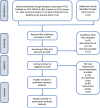Pediatric hypnic headache: a systematic review
- PMID: 37638182
- PMCID: PMC10457117
- DOI: 10.3389/fneur.2023.1254567
Pediatric hypnic headache: a systematic review
Abstract
Introduction: Hypnic headache (HH) is a primary headache, and it is considered a rare condition in children. The underlying mechanisms of HH are not yet fully understood. This systematic review aims to provide a comprehensive description of the clinical features of all published cases of pediatric HH. It will also discuss the differences in headache features between children and adults, the increased diagnostic sensitivity of the new diagnostic criteria (ICHD-3), potential pathophysiological hypotheses explaining the higher incidence in adults, differential diagnoses, and therapeutic options for children.
Methods: A systematic search was conducted to identify and analyze articles reporting cases of HH in patients under the age of 18. The search was performed in major medical databases including Cochrane Library, EBSCO, Embase, Medline, PubMed, Science Direct, Scopus, and Web of Science. The search covered the period from 1988 to April 2023. Relevant studies were screened for eligibility, and data extraction was performed using a standardized approach.
Results: Seven children with HH were included in the analysis. The mean age of onset for headache attacks was 10 ± 4.3 years (range 3-15 years). The average time from the start of headaches to diagnosis was 15.8 ± 25.0 months (range 1-60 months). Headache features in children differed from those observed in adult HH patients. Children experienced throbbing/pulsating pain, while adults reported dull/pressure-like pain. Children also had lower frequency and shorter duration of attacks compared to adults. The use of ICHD-3 criteria appeared to be more sensitive and inclusive for diagnosing HH in children compared to the previous ICHD-2 criteria. The association of headache attacks with sleep suggests that HH may be a primary disorder with a chronobiological origin. Hypothalamic dysfunction and melatonin dysregulation, which are more prevalent in older individuals, could potentially explain the higher incidence of HH in adults. Other primary headaches and secondary causes should be ruled out. Melatonin prophylactic therapy may be considered for pediatric patients.
Discussion: Further evaluation of the clinical features of HH in children is needed. The development of specific diagnostic criteria for pediatric cases could improve diagnostic rates and enhance the management of children with HH.
Keywords: child; hypnic headache; international classification of headache disorders 3rd edition; melatonin; primary headache; sleep; systematic review.
Copyright © 2023 Ferretti, Velardi, Fanfoni, Di Nardo, Evangelisti, Foiadelli, Orsini, Del Pozzo, Terrin, Raucci, Striano and Parisi.
Conflict of interest statement
The authors declare that the research was conducted in the absence of any commercial or financial relationships that could be construed as a potential conflict of interest.
Figures
References
Publication types
LinkOut - more resources
Full Text Sources
Miscellaneous


